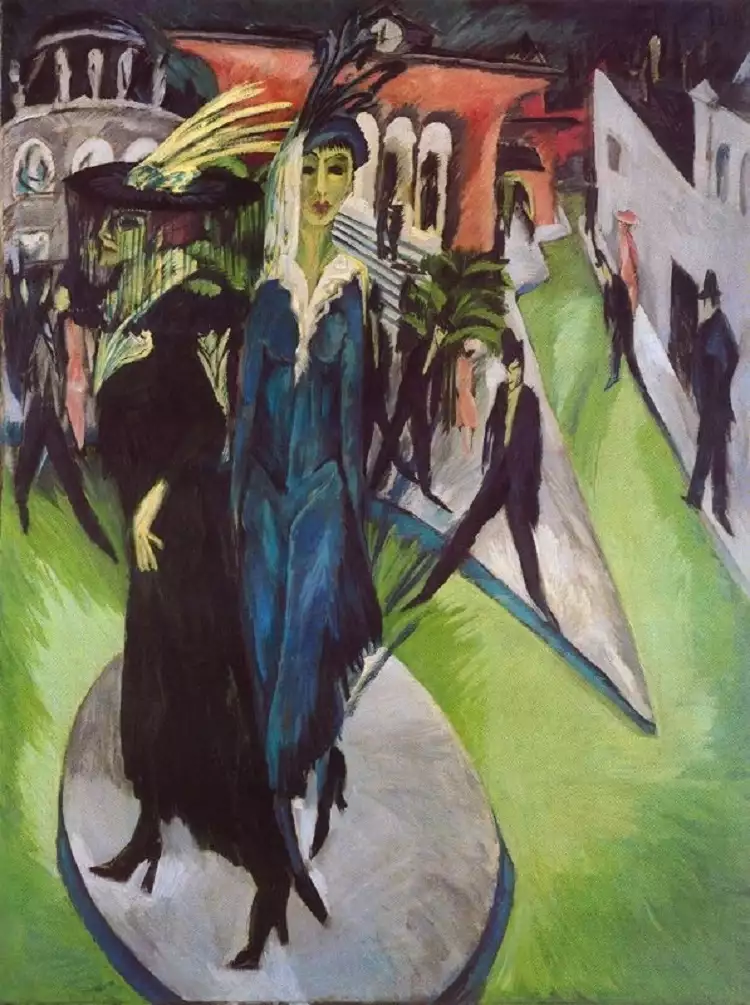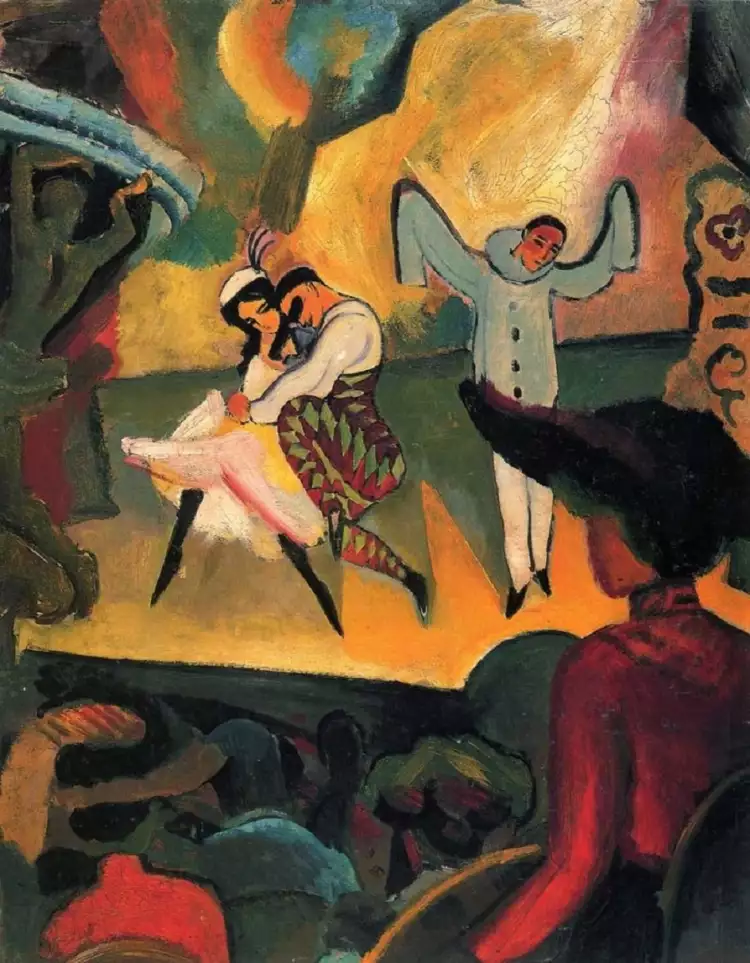
Expressionism - a shocking emotional movement in 20th-century art
Expressionism is a movement in the global visual arts, literature, music, cinema, theater, and architecture of the 20th century. Its founders rejected the idea of replicating reality in a traditional manner and instead saw expressionism as a means of artistically expressing the author's emotional state. To realize their creative ideas, expressionists used innovative methods such as distorted lines, contrasting colors, abstract forms, exaggeration, and simplification.
 Expressionism. Max Beckmann. Noon, 1946
Expressionism. Max Beckmann. Noon, 1946
Expressionism acknowledged the author's right to have a shocking impact on the audience, contrary to the established standards in painting. Artists aimed to provoke a storm of emotions in viewers and often explored themes of disappointment, anger, pain, fear, and anxiety.
History of Expressionism
Expressionism emerged in early 20th-century Germany on the eve of World War I, during a period of rapid industrial development in Europe and the mass growth of revolutionary sentiments in society. Many people were disoriented, old moral values were rapidly eroding, and expressionists were among the first to sense the impending catastrophe and the grotesqueness and contradictions of the surrounding world.
Expressionistic motifs in art can be discerned long before the emergence of this new movement. Expressive distortions of artistic images are present in the works of El Greco, and Matthias Grünewald's paintings are characterized by extreme emotionality. Expressionists acknowledged the strong influence of these masters on their own art and considered them predecessors of their style.
 Expressionism. El Greco. The Opening of the Fifth Seal (or The Vision of Saint John), 1608-1614
Expressionism. El Greco. The Opening of the Fifth Seal (or The Vision of Saint John), 1608-1614
In the works of many post-impressionists, one can also notice principles of simplifying perspective and intense emotional expression, which align with expressionist ideas. This is the hallmark of paintings by Vincent van Gogh, Paul Cézanne, Henri Matisse, and Paul Gauguin. Representatives of the new artistic movement skillfully utilized the experience of these masters but significantly increased the level of expression in their own works.
The official birthdate of expressionism is considered to be June 7, 1905. On that summer day in Dresden, four promising architects founded the art group "Die Brücke". They were:
- Ernst Ludwig Kirchner - the initiator of the group's creation.
- Karl Schmidt-Rottluff - coined the name "Die Brücke."
- Erich Heckel.
- Fritz Bleyl.
Later, new like-minded individuals joined them:
- Emil Nolde.
- Max Pechstein.
- Cuno Amiet.
- Bohumil Kubišta, and dozens of other young people.
By the time of its dissolution in 1913, "Die Brücke" counted more than 70 participants.
 Expressionism. Yuri Pimenov. Disabled war veterans, 1926
Expressionism. Yuri Pimenov. Disabled war veterans, 1926
These young artists shared a rejection of the overly superficial realism of Impressionism. They aimed to restore spirituality and profound meaning to art. The group's members even developed their own aesthetic vocabulary and group style. As a result, many paintings bore a strong resemblance in terms of style and subject matter.
In December 1911, another prominent association of Expressionists, the "Blue Rider" (Der Blaue Reiter), was formed in Munich. Its active members included:
- Wassily Kandinsky (Russian: Василий Кандинский).
- Franz Marc.
- Marianne von Werefkin (Russian: Марианна Верёвкина).
- Alexej von Jawlensky (Russian: Алексей Явленский).
- August Macke.
- Alfred Kubin.
However, the work of the members of this association expressed Expressionism with less emotional intensity. Their paintings revealed a desire for harmony, and the inner world of the authors was not overwhelmed by dark thoughts.
 Expressionism. Wassily Kandinsky. Summer landscape, 1909
Expressionism. Wassily Kandinsky. Summer landscape, 1909
Besides Germany, Expressionism experienced a period of rapid growth in other European countries. Renowned representatives of the style included:
- In France - Amedeo Modigliani, Georges Rouault.
- In Austria - Egon Schiele.
- In Romania - Nicolae Tonitza.
- In Norway - Edvard Munch.
- In Belgium - Constant Permeke.
- In the Netherlands - Jan Sluijters.
- In the USA - Clyfford Still, Jackson Pollock, Hans Hofmann.
- In Russia - Marc Chagall (Russian: Марк Шагал), Pavel Filonov (Russian: Павел Филонов), Yuri Pimenov (Russian: Юрий Пименов).
The decline of interest in Expressionism in Germany and later in the rest of Europe began after the stabilization of post-war life. It was challenging for the general public to comprehend artistic works, and society grew weary of negativity, leading to a need for more optimistic creativity.
 Expressionism. Marc Chagall. Red Jew, 1915
Expressionism. Marc Chagall. Red Jew, 1915
With the rise of Hitler to power, the movement suffered an irreparable blow. The Nazis strongly disapproved of avant-garde trends in painting, and expressionists faced persecution, with their artworks officially declared "degenerate art." Artists were not allowed to hold exhibitions, and their works were systematically destroyed.
However, in the 1940s, Abstract Expressionism began to take shape in America, and in the late 1970s, Neo-Expressionism made its mark on global culture.
Distinctive Features of Expressionism
An experienced art connoisseur can easily identify the work of an expressionist based on characteristic features:
- Deliberate distortion of proportions of objects and people in the painting to artistically intensify the viewer's impression.
- Simplification of the drawing, with the artist abandoning meticulous detailing of the smallest details.
- Dominance of sharp contours of objects in the composition.
- Deep emotional content in the creative concept, with an abundance of strong feelings: horror, fear, anger, or delight.
- Emphasis on vibrant color choices and extremely sharp contrasts.
 Expressionism. Franz Marc. Naked in the trees, 1911
Expressionism. Franz Marc. Naked in the trees, 1911
In many paintings, the author's pessimism is clearly evident, along with a sense of uncertainty about the future and a lack of even the slightest hope for a better situation.
Famous Expressionist Artists
The fates of the best representatives of Expressionism varied. Some of them achieved recognition during their lifetime and lived to a comfortable old age, while others could not survive the catastrophic events of World War I and departed prematurely to a better world.
Among the numerous figures deserving individual attention, we will highlight only a few of the most well-known names, in our view:
- Edvard Munch — without exaggeration, a true symbol of Expressionism. His painting "The Scream" is easily recognizable and highly popular among viewers. One of the four versions created by the great Norwegian was sold at a Sotheby's auction for $119.9 million. The master's legacy was appreciated not only by Expressionists but also by contemporary audiences. Munch gravitated towards Expressionism in the early stages of his career. Most of his paintings in this style were created before 1908. A naturally frail artist miraculously survived the Spanish flu, experienced serious health problems towards the end of his life, and almost stopped painting, but he lived to be 80 years old.
 Expressionism. Edvard Munch. The Scream, 1893
Expressionism. Edvard Munch. The Scream, 1893
- Ludwig Kirchner — the founder of a new movement in visual arts. His works are characterized by a remarkable dramatic tension. In his art, the German artist often turned to the genre of urban landscapes and was an unsurpassed master of the grotesque. With the rise of the Nazis to power, he faced devastating criticism, his paintings were removed from museums, and some of his works were demonstratively destroyed. In deep depression, Kirchner became addicted to drugs and took his own life at the age of 58.
 Expressionism. Ernst Ludwig Kirchner. Potsdamer Platz, 1914
Expressionism. Ernst Ludwig Kirchner. Potsdamer Platz, 1914
- August Macke — a man who lived a vibrant but short life. He was an active member of the "Blue Rider" group, easily captivated by new ideas, and painted pictures full of vitality. With the onset of World War I and a wave of patriotism, he volunteered for active duty in the military. He perished on the front lines in late September 1914 at the age of 27. His body was never found on the battlefield, and Macke's name is immortalized on a gravestone at one of the military cemeteries.
 Expressionism. August Macke. Russisches Ballett, 1912
Expressionism. August Macke. Russisches Ballett, 1912
- Amedeo Modigliani — a renowned master of portraiture and nudes. Born in Italy, he spent most of his conscious life in France. Modigliani's work cannot be unequivocally attributed to a specific painting style, but vivid Expressionist motifs are clearly evident in many of his works. He achieved recognition during his lifetime, enjoyed success at exhibitions, but succumbed suddenly to tuberculosis at the age of 35.
 Expressionism. Amedeo Clemente Modigliani. Portrait of Margaret, 1916
Expressionism. Amedeo Clemente Modigliani. Portrait of Margaret, 1916
- Egon Schiele — an Austrian master of painting and drawing. His works are vivid examples of disharmony and a challenge to society. He painted a lot of nudes and portraits and wrote poetry. Gustav Klimt supported the young artist. Schiele was even considered the greatest Austrian artist at one point. But fate had other plans. In late October 1918, his wife died of the Spanish flu, and three days later, the artist himself passed away.
 Expressionism. Egon Schiele. The Family, 1918
Expressionism. Egon Schiele. The Family, 1918
Expressionism left a significant mark on the world of painting. It went through a tumultuous journey from complete rejection and attacks to modern global recognition. The works of outstanding masters command high prices, and exhibitions attract large audiences. Visitors to the Very Important Lot website can participate in auctions to purchase works by well-known Expressionists. Additionally, here, you can directly acquire works by contemporary artists.
 Surrealism is art from the depths of the human subconscious
Surrealism is art from the depths of the human subconscious  Ecole de Paris and other masters online auction on drouot.com, until 5 dec 2023
Ecole de Paris and other masters online auction on drouot.com, until 5 dec 2023  Mural - monumental urban art of immense scale
Mural - monumental urban art of immense scale  Kuznetsov porcelain
Kuznetsov porcelain  Cubism - a modernist style in 20th-century painting: the essence of the movement, history, and stages of development
Cubism - a modernist style in 20th-century painting: the essence of the movement, history, and stages of development  Fernando Botero is the most famous artist in Latin America
Fernando Botero is the most famous artist in Latin America  The painting "The Yellow House" by Vincent van Gogh is a dwelling of light in the artist's work
The painting "The Yellow House" by Vincent van Gogh is a dwelling of light in the artist's work  Renaissance is an era of great names
Renaissance is an era of great names  The top 10 most famous photographers in the world - the best photo artists of all time
The top 10 most famous photographers in the world - the best photo artists of all time  The painting "The Adoration of the Trinity" by Albrecht Dürer - The City of God through the eyes of the artist
The painting "The Adoration of the Trinity" by Albrecht Dürer - The City of God through the eyes of the artist